Mirror selfies have become a cultural phenomenon, driving smartphone manufacturers to push camera technology to new heights. You've likely noticed the evolution from basic front-facing cameras to advanced multi-lens systems and AI-powered features. This trend has sparked innovations in lighting, composition, and editing tools specifically designed for reflective surfaces. As users experiment with creative angles and unconventional mirror placements, smartphones adapt to meet these demands. The social media influence of mirror selfies has led to a constant cycle of improvement in smartphone photography capabilities. Discover how this seemingly simple trend is shaping the future of mobile imaging technology.
The Rise of Mirror Selfies
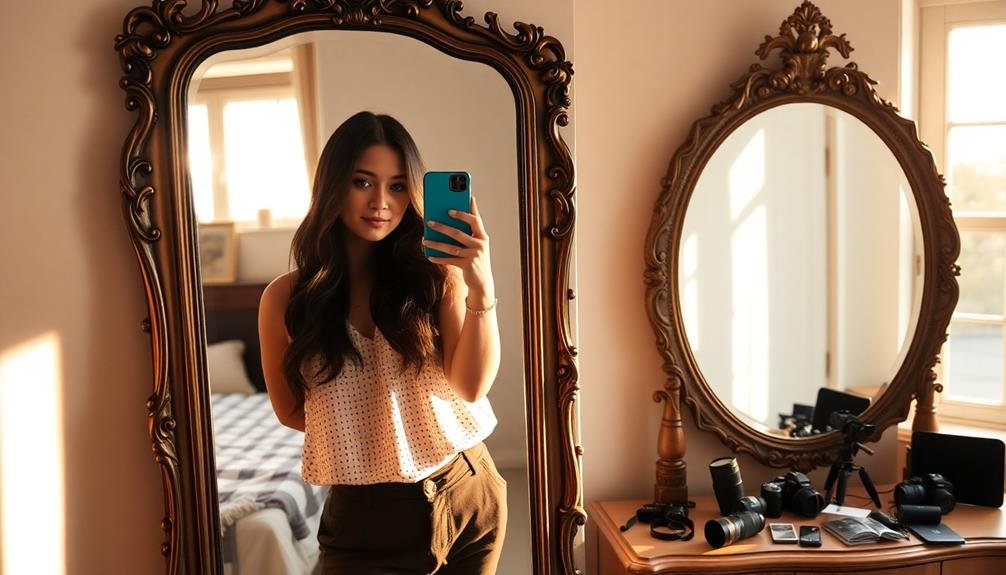
As smartphones became ubiquitous, mirror selfies quickly emerged as a popular form of self-expression. You've likely seen or taken one yourself: a photo captured in a mirror, showcasing both the photographer and their device. This trend gained traction for several reasons.
Mirror selfies offer a wider field of view than traditional selfies, allowing you to capture more of your outfit or surroundings. They also give you greater control over composition and pose, as you can see yourself in real-time while taking the photo. This format has become particularly popular on social media platforms like Instagram, where users endeavor to create visually appealing and unique content.
The rise of mirror selfies has influenced smartphone design and features. Manufacturers have responded by improving front-facing camera quality, adding wide-angle lenses, and developing AI-powered portrait modes. You'll find that many newer phones now include specific settings optimized for mirror selfies.
As this trend continues to evolve, it's pushing the boundaries of smartphone photography. You're now seeing innovations like dual-screen phones and foldable devices, which offer new possibilities for capturing and sharing mirror selfies in creative ways.
Smartphone Camera Evolution
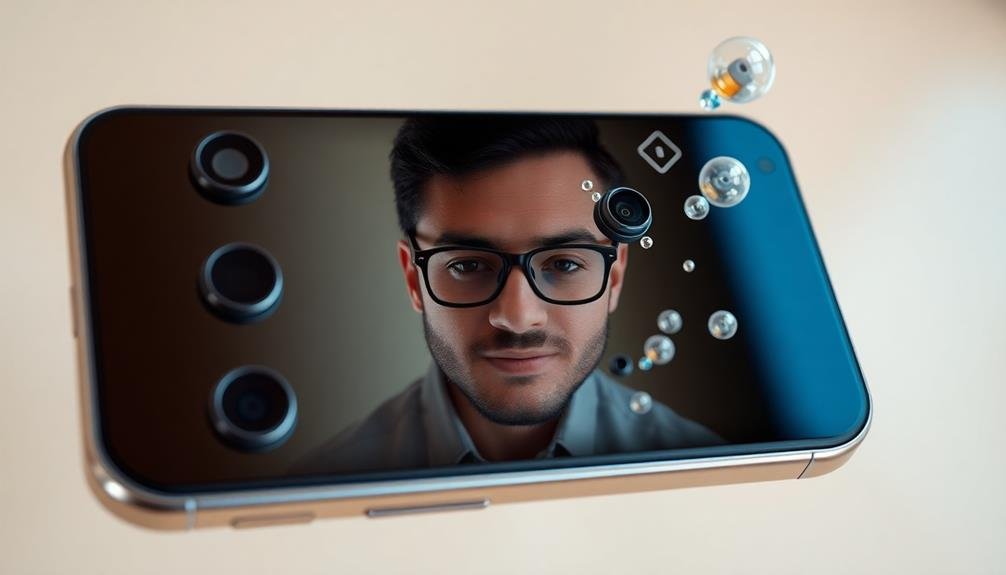
The evolution of smartphone cameras has been nothing short of revolutionary. You've witnessed the transformation from basic, low-resolution sensors to sophisticated multi-lens systems capable of rivaling professional cameras.
Remember when you'd struggle to capture a decent photo in low light? Now, you're effortlessly shooting in near-darkness, thanks to advanced night mode features.
As you've embraced mirror selfies, smartphone manufacturers have responded by enhancing front-facing cameras. You've seen them progress from mere afterthoughts to high-quality shooters with wide-angle lenses and portrait modes.
The rise of social media has driven this innovation, as you've demanded better tools to create shareable content.
You've also experienced the integration of artificial intelligence in your smartphone's camera. It's now helping you compose shots, adjusting settings in real-time, and even suggesting the best moment to capture.
As you continue to push the boundaries of smartphone photography, manufacturers are racing to meet your evolving needs. They're constantly developing new features, from improved optical zoom to advanced image stabilization, ensuring you're always equipped to capture your best shot.
Lighting Techniques for Reflections
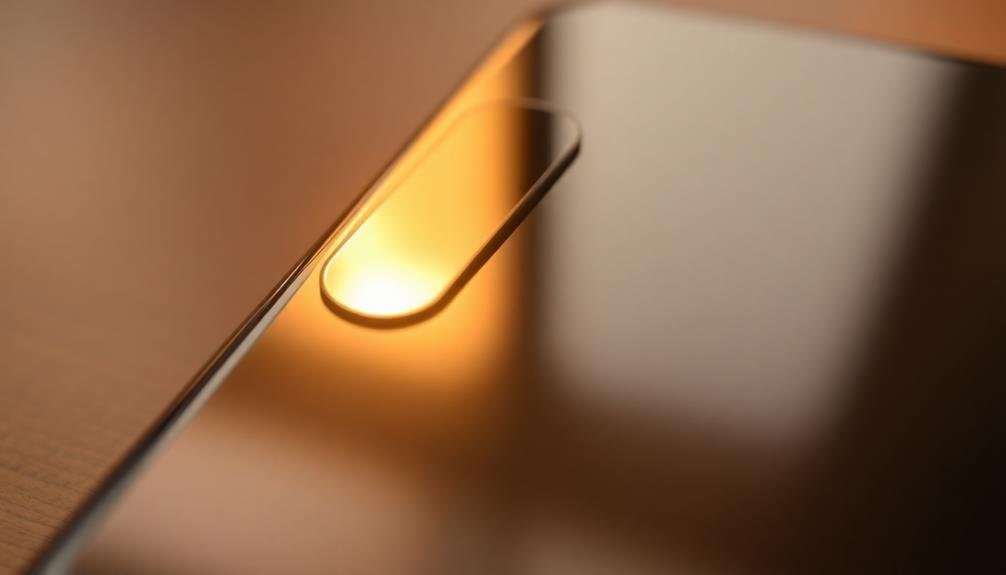
In spite of your smartphone's advanced camera capabilities, mastering lighting techniques for reflections can elevate your mirror selfies to new heights. When dealing with reflective surfaces, you'll need to take into account both direct and indirect light sources. Position yourself at a 45-degree angle to the mirror to minimize harsh shadows and create depth.
Natural light is your best friend for mirror selfies. If possible, face a window to allow soft, diffused light to illuminate your face and surroundings. For evening shots, experiment with warm artificial lighting to create a cozy ambiance. Avoid using your phone's flash, as it can cause unwanted glare and washout your features.
To combat uneven lighting, try using a small LED panel or ring light. These portable devices can help fill in shadows and provide a flattering glow. You can also use reflectors or white surfaces to bounce light back onto your subject, softening harsh contrasts.
Don't forget to clean your mirror and camera lens before shooting. Smudges and dust can interfere with light reflections and compromise image quality.
Composition in Mirror Shots
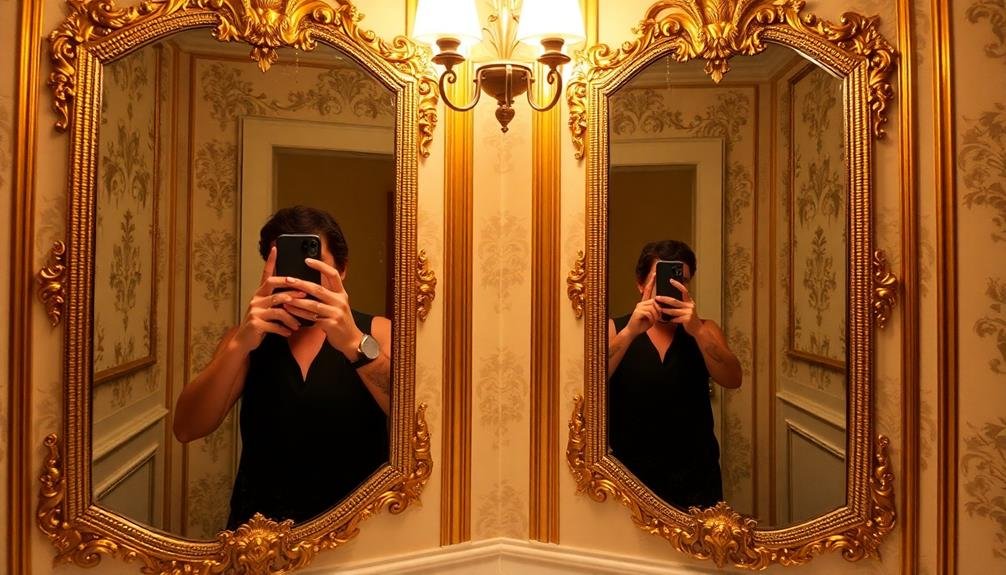
When composing mirror shots, you'll want to experiment with framing using reflective surfaces to create intriguing visual elements.
Try different angles and perspectives to capture unique views and add depth to your images.
Framing With Reflective Surfaces
Three key elements elevate mirror selfies from mundane snapshots to compelling compositions: framing, angle, and background. When framing with reflective surfaces, you're not limited to traditional mirrors. Windows, metallic surfaces, and even water can create intriguing reflections for your shots.
Experiment with different angles to add depth and interest. Tilt your phone or adjust your body position to capture unique perspectives. Don't forget to reflect on the background visible in the reflection – it can enhance or detract from your composition.
Here's a quick guide to framing with reflective surfaces:
| Surface Type | Framing Technique | Lighting Considerations |
|---|---|---|
| Mirrors | Rule of thirds | Avoid harsh reflections |
| Windows | Symmetry | Use natural light |
| Metal | Leading lines | Control glare |
| Water | Negative space | Capture ripples |
| Glass | Frame within frame | Minimize smudges |
Angles and Perspectives
Angles and perspectives can make or break your mirror selfies. When composing your shot, consider how you're positioning yourself in relation to the mirror and your smartphone.
Experiment with different angles to create unique and visually appealing images. You'll find that slight adjustments can dramatically change the overall look and feel of your selfie.
Don't be afraid to play with unconventional perspectives. Try capturing your reflection from above, below, or at an oblique angle.
These creative choices can add depth and intrigue to your mirror selfies, setting them apart from the typical straight-on shots.
Consider these techniques to enhance your mirror selfie composition:
- Use the rule of thirds to place yourself or key elements off-center
- Incorporate leading lines to draw the viewer's eye through the image
- Create depth by including foreground, middle ground, and background elements
Depth and Layering
Creating depth and layering in mirror selfies can elevate your shots from flat to fascinating. You'll want to experiment with foreground, midground, and background elements to add visual interest. Position yourself strategically in relation to the mirror, ensuring that you're not blocking key elements of the scene behind you.
Consider using objects in the foreground to frame your reflection or create leading lines. You might place a vase of flowers on a nearby table or position yourself behind a doorway. In the midground, focus on your reflection and any interesting elements in the immediate vicinity of the mirror. The background can include room decor, windows, or even outdoor scenes visible through the mirror.
Here's a quick guide to depth and layering techniques:
| Technique | Foreground | Background |
|---|---|---|
| Framing | Door frame | Room decor |
| Leading lines | Furniture edges | Window view |
| Contrast | Close-up objects | Distant scene |
| Reflections | Mirror surface | Room behind |
| Layered reflections | Multiple mirrors | Varied depths |
Creative Angles and Perspectives
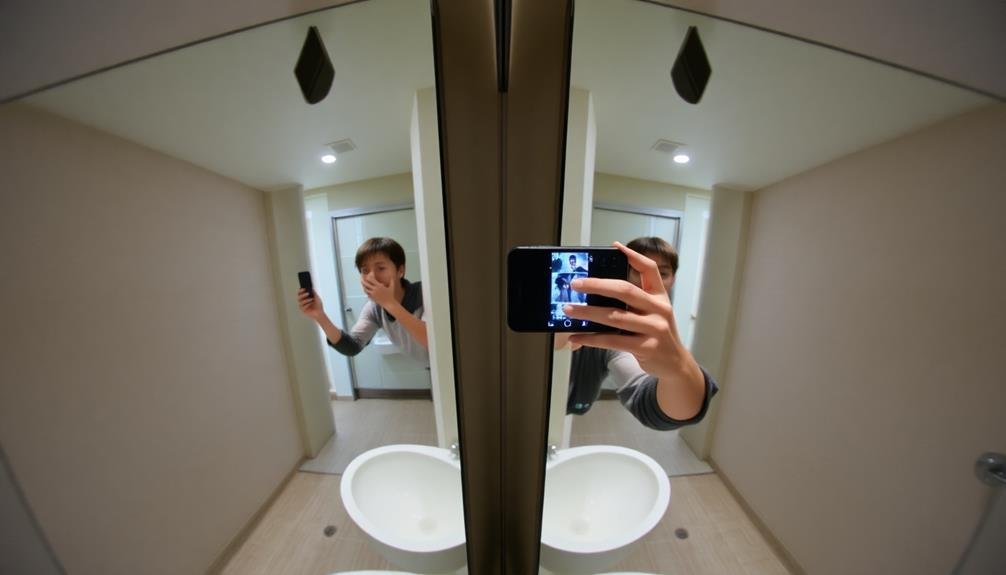
To elevate your mirror selfies, experiment with unconventional mirror placements, such as floor-length mirrors angled from above or small hand mirrors positioned creatively.
You'll discover new dimensions by exploring reflective surfaces beyond traditional mirrors, like polished metal or water.
Try various body positions and angles to create dynamic compositions that challenge the typical mirror selfie aesthetic.
Unusual Mirror Placements
Innovative photographers are pushing the boundaries of mirror selfies by experimenting with unconventional mirror placements. You'll find mirrors positioned in unexpected locations, creating unique reflections and perspectives that challenge traditional selfie compositions. By placing mirrors in nature, urban environments, or even underwater, you can capture stunning images that blend reality with reflection.
Consider these unusual mirror placements for your next selfie:
- Mirrors submerged in clear water bodies, creating a dreamy, ethereal effect
- Reflective surfaces mounted on trees or rock formations in natural settings
- Mirrors strategically placed in abandoned buildings or urban decay scenes
These unconventional setups allow you to play with depth, symmetry, and surrealism in your self-portraits. You'll create visual puzzles that engage viewers and spark curiosity about the image's construction.
Experiment with different mirror sizes, shapes, and angles to further enhance the effect. Don't be afraid to combine multiple mirrors or incorporate other reflective surfaces like puddles or metal objects.
Reflective Surface Experimentation
Beyond unconventional mirror placements, photographers are now exploring a wide array of reflective surfaces for their selfies. You'll find creative minds using everything from puddles to polished metal surfaces to capture unique self-portraits. This experimentation has led to a surge in innovative techniques and perspectives in smartphone photography.
When you're looking to try reflective surface experimentation, consider these options:
| Surface | Indoor | Outdoor |
|---|---|---|
| Water | Pools, Bathtubs | Puddles, Lakes |
| Glass | Windows, Tabletops | Car Windows, Buildings |
| Metal | Appliances, Fixtures | Urban Structures, Sculptures |
Each surface offers distinct characteristics that can transform your selfie. Water adds a rippling effect, while glass can create interesting distortions. Metal surfaces often provide a sleek, modern aesthetic.
You'll want to pay attention to lighting when working with these surfaces. Natural light can enhance reflections in outdoor settings, while artificial light sources can be manipulated for dramatic effects indoors. Don't be afraid to play with angles and distances to discover unexpected compositions. This experimentation not only results in enchanting images but also pushes the boundaries of what's possible with smartphone photography.
Body Position Techniques
Smartphone photographers' creativity extends beyond reflective surfaces to encompass innovative body positioning techniques. You'll find that mastering these techniques can dramatically enhance your mirror selfies and push the boundaries of smartphone photography.
Experiment with unconventional angles by positioning your body at various levels. Crouch down for a low-angle shot that creates a sense of power, or reach high for a bird's-eye view that offers a unique perspective. Don't be afraid to twist, turn, or contort your body to achieve striking compositions.
Consider the interplay between your body and the surrounding environment. Use architectural elements, furniture, or natural scenery to frame yourself in interesting ways. You can create depth by placing objects in the foreground or background, adding layers to your composition.
Here are three body positioning techniques to try:
- The "Dutch angle": Tilt your phone and body to create a diagonal composition
- The "Reflection within a reflection": Use multiple mirrors to capture different angles simultaneously
- The "Partial reveal": Show only part of your body, leaving the rest to the viewer's imagination
Editing Apps for Reflection Photos
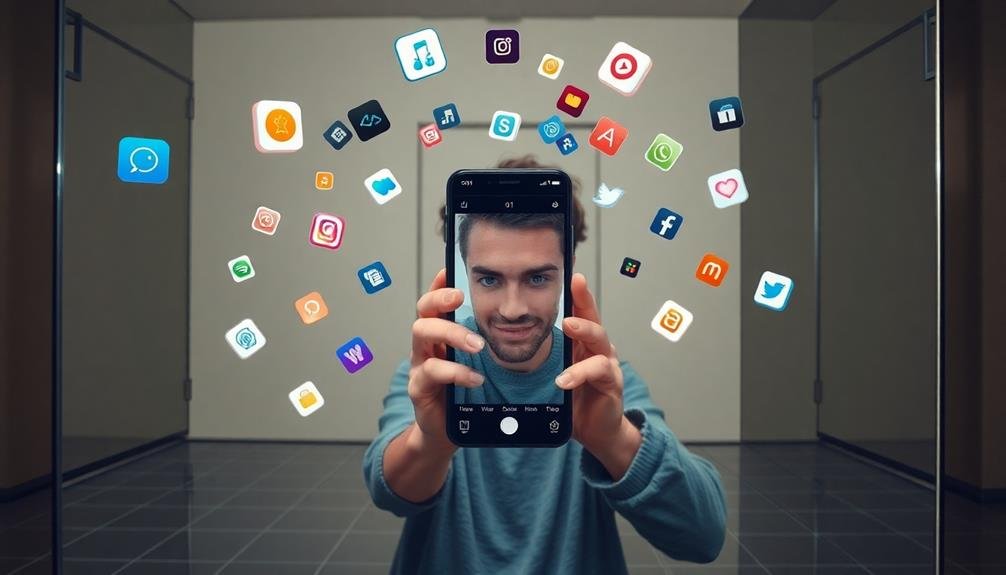
Countless editing apps have emerged to enhance reflection photos, catering specifically to mirror selfies and other reflective surfaces. You'll find tools designed to remove smudges, fingerprints, and dust from mirrors, giving your photos a cleaner look.
Some apps offer features to adjust lighting and reduce glare, helping you overcome common issues with reflective surfaces. You can use apps that provide filters and presets tailored for mirror selfies, enhancing colors and textures while maintaining a natural appearance.
Many of these apps include advanced editing tools like selective adjustments, allowing you to fine-tune specific areas of your reflection photo. For creative mirror selfies, you'll discover apps with unique effects like double exposure or kaleidoscope features.
These tools let you blend multiple images or create symmetrical patterns within your reflection shots. Some apps even offer AI-powered enhancements that can automatically detect and improve reflective surfaces in your photos.
When editing, pay attention to perspective correction tools that can help straighten tilted mirror images. Finally, don't overlook apps that provide frames and borders designed to complement mirror selfies, adding a polished finish to your reflection photos.
Smartphone Accessories for Mirror Selfies
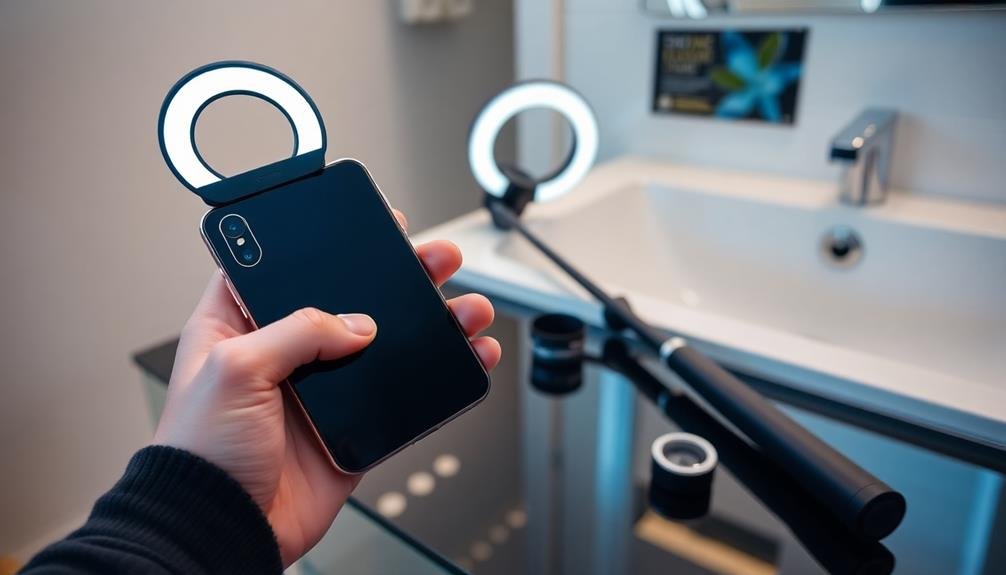
To elevate your mirror selfies, you'll want to explore some essential smartphone accessories.
Clip-on wide-angle lenses can capture more of your surroundings, while extendable selfie sticks allow for creative angles and full-body shots.
For precise control over your shots, consider using remote shutter controls, which let you snap photos without touching your phone.
Clip-On Wide-Angle Lenses
With the rise of mirror selfies, clip-on wide-angle lenses have become a popular smartphone accessory. These compact attachments expand your phone's field of view, allowing you to capture more of your surroundings in your mirror selfies.
You'll find that wide-angle lenses are particularly useful when you're in smaller spaces or want to include more people in your shot.
When shopping for a clip-on wide-angle lens, consider these key features:
- Lens quality: Look for multi-element glass lenses for better image clarity
- Compatibility: Confirm the lens fits your specific smartphone model
- Ease of use: Choose lenses with secure, quick-attach mechanisms
You'll notice a significant difference in your mirror selfies when using a wide-angle lens. They're especially effective for full-body shots, allowing you to capture your entire outfit without having to stand too far from the mirror.
Additionally, these lenses can help you showcase more of your room's decor or the ambiance of your location.
Remember that wide-angle lenses may introduce some distortion, particularly around the edges of your images.
Experiment with different angles and distances to find the sweet spot that works best for your style of mirror selfies.
Extendable Selfie Sticks
Extendable selfie sticks have revolutionized mirror selfies by allowing you to capture unique angles and wider shots.
These handy accessories attach to your smartphone and extend up to several feet, giving you more control over your image composition. You'll find it easier to include multiple people in your mirror selfies or showcase more of your outfit and surroundings.
When using a selfie stick for mirror shots, you can experiment with different heights and angles.
Try positioning the camera above eye level for a flattering perspective or go low for an artistic view. You'll also appreciate the added stability, reducing blur in your photos.
Many selfie sticks come with Bluetooth remotes, letting you trigger the shutter without touching your phone.
This feature's particularly useful for mirror selfies, as you won't see your arm awkwardly reaching for the screen. Some models even have built-in tripods, perfect for setting up elaborate mirror selfies or recording videos.
Remember to be mindful of your surroundings when using a selfie stick, especially in public spaces.
With practice, you'll master the art of taking mirror selfies that stand out from the crowd.
Remote Shutter Controls
Beyond selfie sticks, remote shutter controls have become indispensable tools for mirror selfie enthusiasts. These devices allow you to trigger your smartphone's camera from a distance, giving you more freedom to compose your shots. You'll no longer need to awkwardly stretch your arm or fumble with on-screen buttons.
Remote shutter controls come in various forms, each offering unique benefits:
- Bluetooth remotes: Compact and wireless, these pair easily with your phone.
- Wired triggers: Plug directly into your headphone jack for instant connectivity.
- Voice-activated controls: Use spoken commands to capture images hands-free.
When choosing a remote shutter control, consider compatibility with your device and preferred shooting style. Some models offer additional features like timers or burst mode options, enhancing your creative possibilities.
You'll find that using a remote shutter control improves the quality of your mirror selfies. It eliminates camera shake, allows for more natural poses, and helps you capture group shots with ease.
AI-Powered Reflection Enhancement Features
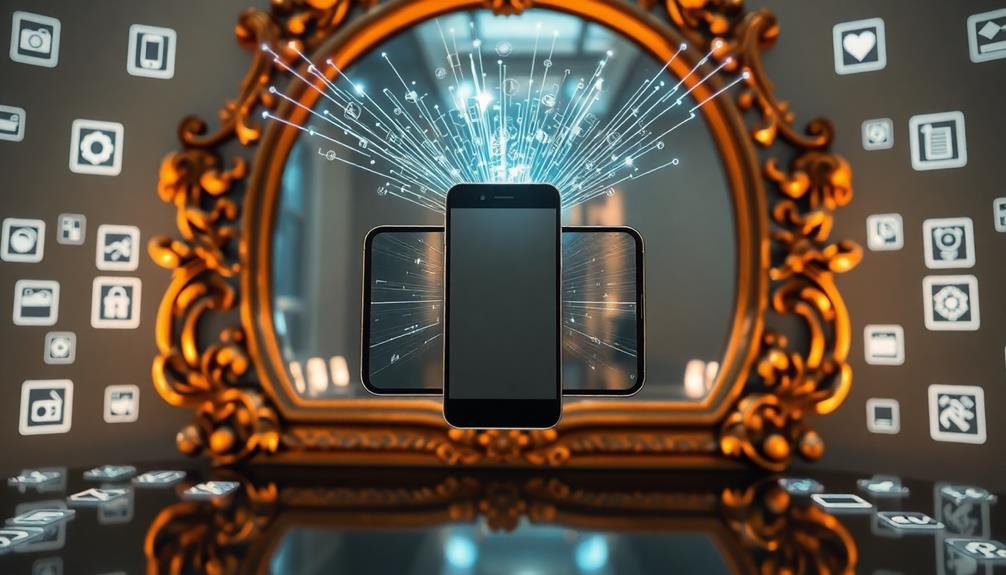
AI-powered reflection enhancement features revolutionize mirror selfies by tackling common issues like poor lighting and unwanted glare. These intelligent algorithms analyze your mirror selfie in real-time, identifying reflective surfaces and adjusting the image accordingly.
You'll notice improved clarity and reduced distortion as the AI compensates for mirror imperfections. It can even remove fingerprints or smudges from the mirror's surface, giving you a cleaner backdrop. The technology also addresses uneven lighting, balancing exposure across the entire frame to guarantee both you and your surroundings are well-lit.
Some advanced features can detect and minimize unwanted reflections, such as camera flashes or bright light sources. You'll also find AI-assisted composition tools that guide you to ideal angles and poses for mirror selfies. These smart features can even suggest virtual decor or frames to enhance your mirror selfie's aesthetic appeal.
As smartphone cameras continue to evolve, you can expect more sophisticated AI-powered reflection enhancement features. They'll offer increasingly natural-looking results, making your mirror selfies indistinguishable from professionally edited photos.
This technology is pushing the boundaries of smartphone photography, making it easier than ever to capture stunning self-portraits in any reflective surface.
Social Media Impact on Trends
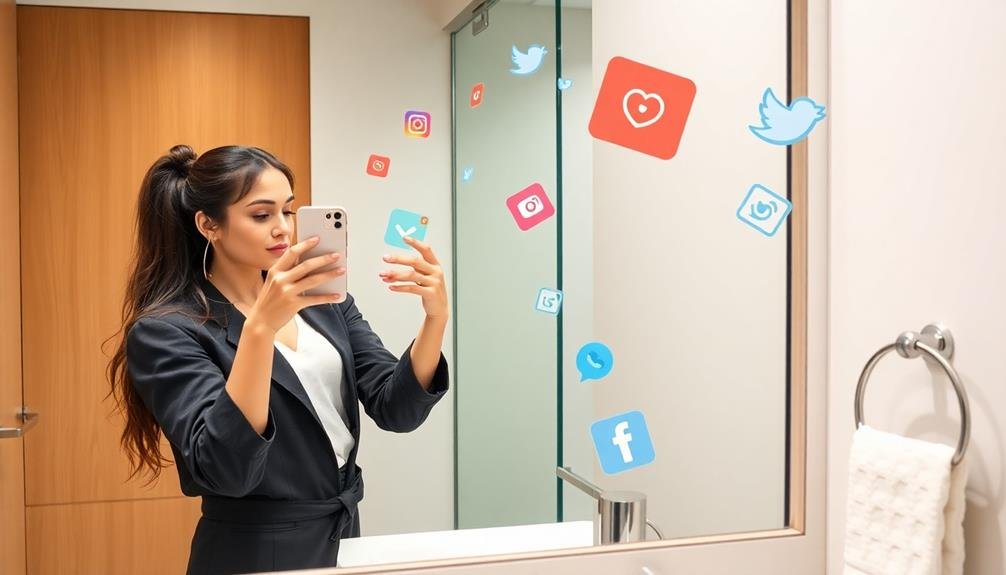
Social media platforms have become the driving force behind mirror selfie trends, shaping how we capture and share these images. As you scroll through Instagram, TikTok, or Snapchat, you'll notice the ever-evolving mirror selfie aesthetics that influencers and everyday users alike adopt.
These platforms not only showcase trends but also inspire smartphone manufacturers to innovate their camera features.
You'll find that social media's impact on mirror selfie trends extends beyond just posing techniques. It influences:
- Lighting preferences, with users seeking ideal setups for their shots
- Background choices, from minimalist spaces to elaborate decor
- Editing styles, including filters and post-processing techniques
As you engage with these platforms, you're unknowingly participating in a feedback loop. Your likes, shares, and comments signal to both content creators and tech companies what's popular.
This data drives the development of new smartphone features tailored to enhance mirror selfies. You'll notice how quickly new trends spread, often starting with influencers and rapidly trickling down to the broader user base.
Smartphone makers are constantly racing to keep up, integrating popular effects and tools directly into their native camera apps.
Future of Reflection Photography Technology
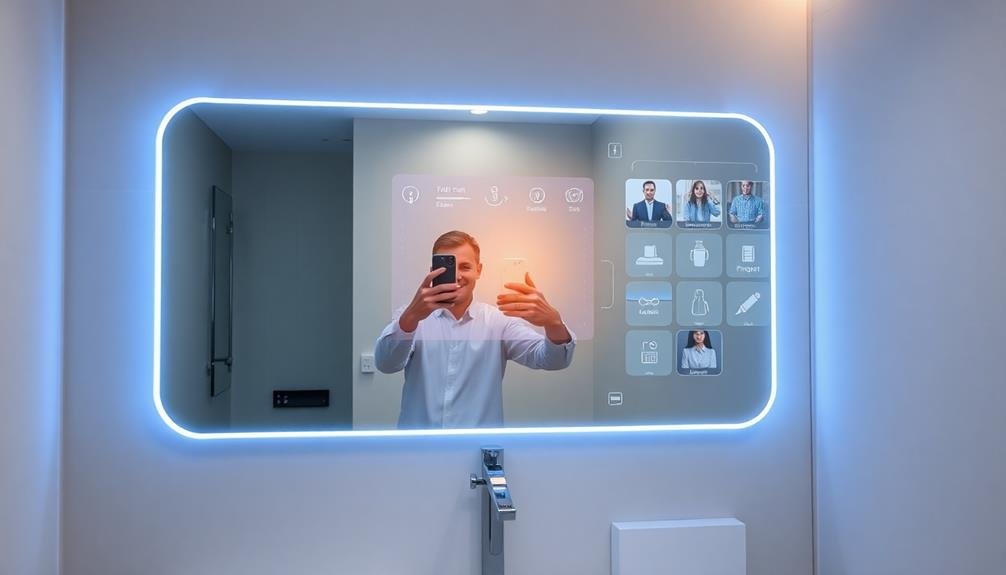
Innovators in the tech industry are already envisioning the next leap in reflection photography. You'll soon see smart mirrors with built-in cameras, allowing you to capture perfect selfies without holding a device. These mirrors will use AI to suggest ideal poses and lighting, enhancing your self-portraits effortlessly.
Augmented reality (AR) will play a significant role in the future of reflection photography. You'll be able to try on virtual outfits, hairstyles, and makeup in real-time, capturing the results instantly. Holographic displays may even replace traditional mirrors, projecting your image in 3D and allowing for 360-degree views.
| Technology | Features | Benefits |
|---|---|---|
| Smart Mirrors | AI-powered cameras | Hands-free selfies |
| AR Integration | Virtual try-ons | Enhanced creativity |
| Holographic Displays | 360-degree views | Immersive experience |
As reflection photography evolves, you'll see a shift towards more interactive and personalized experiences. Wearable devices might project virtual mirrors onto any surface, while advanced editing tools will let you manipulate reflections in real-time. The future of reflection photography isn't just about capturing images; it's about reimagining how you see and present yourself in the digital world.
Frequently Asked Questions
Are Mirror Selfies Considered Narcissistic?
While some may view mirror selfies as narcissistic, they're not inherently so. You're simply capturing a moment or your appearance. It's your intention and frequency that matter more than the act itself. Moderation is key.
How Do Mirror Selfies Affect Body Image and Self-Perception?
Mirror selfies can greatly impact how you view yourself. They'll let you see your whole body, potentially boosting or lowering your self-esteem. You might become more critical of your appearance or find new ways to appreciate yourself.
Can Mirror Selfies Be Used Professionally in Personal Branding?
You can use mirror selfies for personal branding. They're versatile and show authenticity. Capture your style, workspace, or products. Be mindful of background and lighting. Maintain professionalism and consistency with your brand image.
What Are the Cultural Differences in Mirror Selfie Trends Globally?
You'll notice cultural differences in mirror selfie trends worldwide. In some countries, they're more casual, while others emphasize style. Asian cultures often focus on cute poses, while Western trends lean towards showcasing outfits or locations.
How Do Mirror Selfies Impact Privacy and Data Security Concerns?
When you take mirror selfies, you're sharing more than just your image. They can reveal personal details in reflections, potentially exposing your location or belongings. Be mindful of what's visible to protect your privacy and data security.
In Summary
You've seen how mirror selfies have revolutionized smartphone photography. They've pushed camera tech forward, inspired new lighting and composition techniques, and driven accessory innovation. As you experiment with creative angles and AI-enhanced reflections, you're part of a trend that's reshaping social media. Looking ahead, you'll find even more advanced reflection photography features in your devices, ensuring mirror selfies remain at the cutting edge of smartphone imagery.

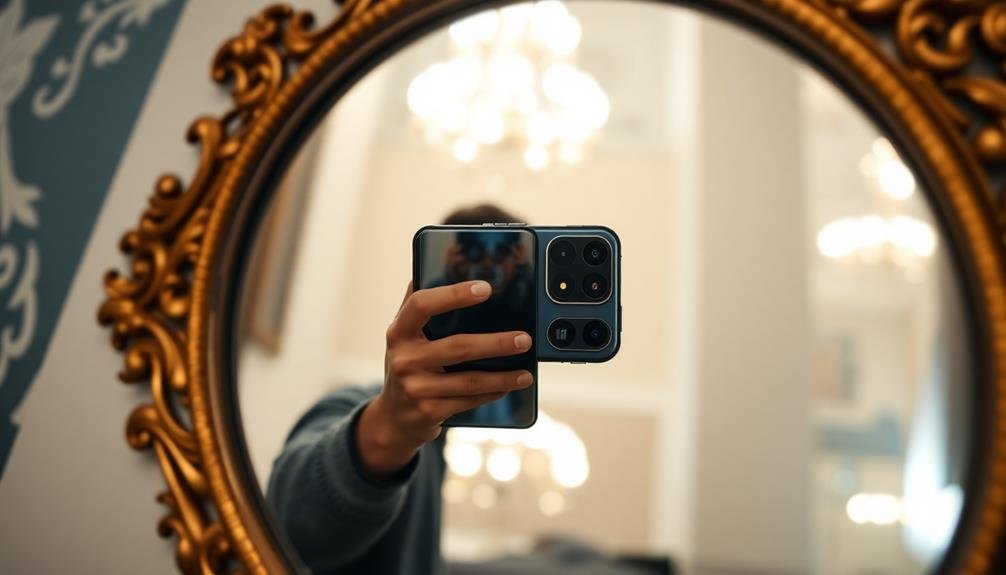



Leave a Reply